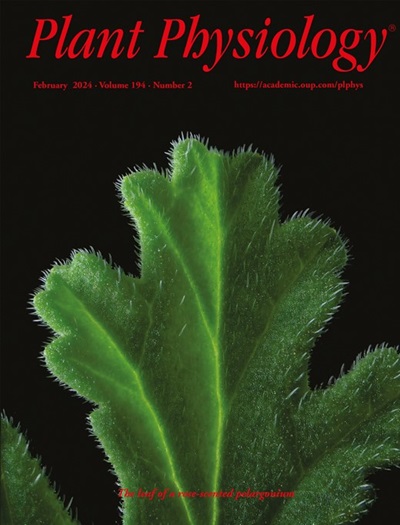A point mutation in PsbW disrupts thylakoid membrane organization and causes aberrant starch granule formation
IF 6.5
1区 生物学
Q1 PLANT SCIENCES
引用次数: 0
Abstract
Chloroplast thylakoid membranes are the sites of the light reactions of photosynthesis. They are also thought to influence starch granule biogenesis via the thylakoid anchored protein MAR-BINDING FILAMENT-LIKE PROTEIN 1 (MFP1), but mechanistic understanding is scarce. Here we report an Arabidopsis mutant affected in PsbW, an integral thylakoid membrane protein associated with photosynthetic complexes of PSII. This mutant (psbw-2) was identified in a large-scale mutant screen designed to find proteins that regulate starch granule shape and size because it produces an excessive number of small, irregularly shaped starch granules. The mutation in psbw-2 causes a glycine-to-arginine substitution in PsbW’s transmembrane helix. The resulting PsbWG107R protein remains membrane-associated but has lost its ability to stabilize PSII supercomplexes. In addition, the transgenic expression of this mutated version results in abnormal thylakoid membranes that have drastically enlarged luminal spaces and no longer form distinct grana stacks, leading to reduced plant growth and impaired photosynthesis. These effects increase with PsbWG107R expression levels but are not observed in the psbw knockout mutant, suggesting that PsbWG107R has acquired an aberrant function. We analyzed psbw-2 mutants also lacking either MFP1 or STARCH SYNTHASE 4, a key factor involved in granule initiation and growth. These data suggest that thylakoid distortion is caused by the membrane insertion of PsbWG107R, which in turn affects the initiation and growth of starch granules. Our results reaffirm the link between thylakoid membrane system and starch formation and highlight the importance of proper thylakoid architecture for plant fitness.PsbW的一个点突变破坏了类囊体膜组织并导致异常淀粉颗粒的形成
叶绿体类囊体膜是光合作用光反应的场所。它们也被认为通过类囊体锚定蛋白mar结合丝状蛋白1 (MFP1)影响淀粉颗粒的生物形成,但机制了解很少。在这里,我们报道了一个受PsbW影响的拟南芥突变体,PsbW是与PSII光合复合物相关的整体类囊体膜蛋白。这个突变体(psbw-2)是在一个大型突变体筛选中发现的,该筛选旨在寻找调节淀粉颗粒形状和大小的蛋白质,因为它产生过多的小的、不规则形状的淀粉颗粒。PsbW -2的突变导致PsbW的跨膜螺旋发生甘氨酸到精氨酸的取代。由此产生的PsbWG107R蛋白仍然与膜相关,但失去了稳定PSII超复合物的能力。此外,这种突变版本的转基因表达导致类囊体膜异常,其管腔空间急剧扩大,不再形成独特的颗粒堆,导致植物生长减少和光合作用受损。这些影响随着PsbWG107R表达水平的增加而增加,但在psbw敲除突变体中未观察到,这表明PsbWG107R获得了异常功能。我们分析了psbw-2突变体也缺乏MFP1或淀粉合酶4,淀粉合酶4是参与颗粒形成和生长的关键因子。这些数据表明,类囊体扭曲是由PsbWG107R的膜插入引起的,从而影响淀粉颗粒的起始和生长。我们的研究结果重申了类囊体膜系统与淀粉形成之间的联系,并强调了适当的类囊体结构对植物适应性的重要性。
本文章由计算机程序翻译,如有差异,请以英文原文为准。
求助全文
约1分钟内获得全文
求助全文
来源期刊

Plant Physiology
生物-植物科学
CiteScore
12.20
自引率
5.40%
发文量
535
审稿时长
2.3 months
期刊介绍:
Plant Physiology® is a distinguished and highly respected journal with a rich history dating back to its establishment in 1926. It stands as a leading international publication in the field of plant biology, covering a comprehensive range of topics from the molecular and structural aspects of plant life to systems biology and ecophysiology. Recognized as the most highly cited journal in plant sciences, Plant Physiology® is a testament to its commitment to excellence and the dissemination of groundbreaking research.
As the official publication of the American Society of Plant Biologists, Plant Physiology® upholds rigorous peer-review standards, ensuring that the scientific community receives the highest quality research. The journal releases 12 issues annually, providing a steady stream of new findings and insights to its readership.
 求助内容:
求助内容: 应助结果提醒方式:
应助结果提醒方式:


